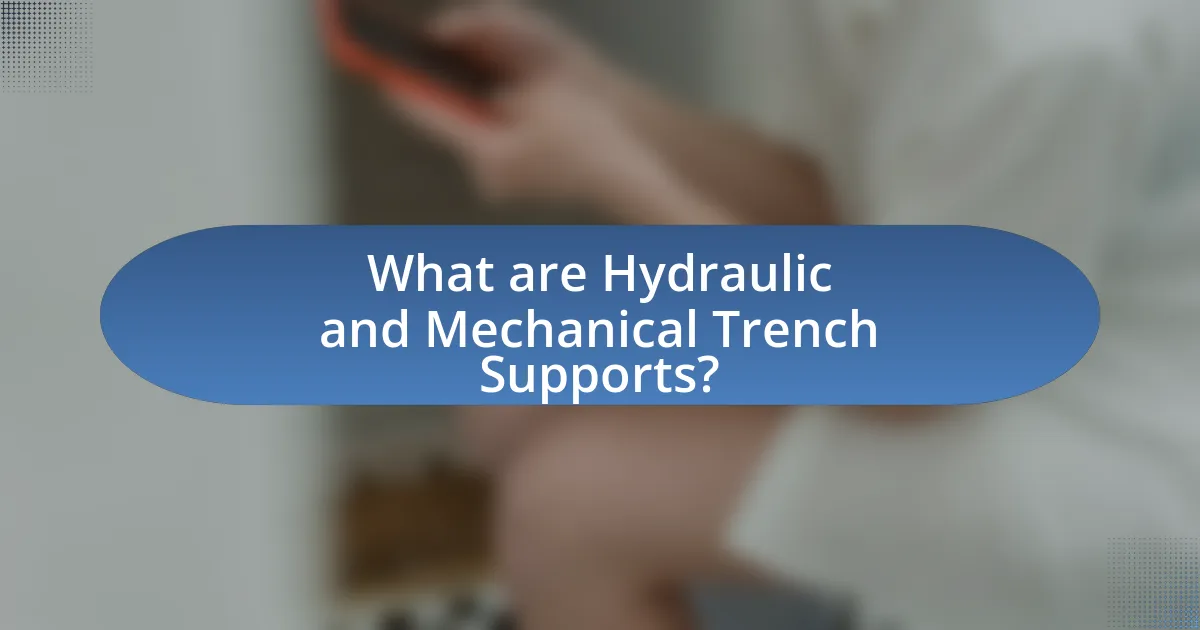Hydraulic and mechanical trench supports are critical systems used in construction and civil engineering to stabilize excavations and prevent soil collapse. Hydraulic trench supports utilize hydraulic pressure for adjustable support, enhancing safety and efficiency, while mechanical trench supports rely on physical structures like braces and struts for stability. This article compares the two systems, detailing their functions, key components, advantages, installation processes, and cost implications. Additionally, it examines factors influencing the choice between hydraulic and mechanical supports, safety considerations, maintenance requirements, and best practices for implementation in construction projects.

What are Hydraulic and Mechanical Trench Supports?
Hydraulic and mechanical trench supports are systems used to stabilize excavations and prevent soil collapse. Hydraulic trench supports utilize hydraulic pressure to provide adjustable support, allowing for quick installation and adaptability to varying trench conditions. Mechanical trench supports, on the other hand, rely on physical structures like braces or struts to hold the trench walls in place, offering a more rigid form of support. Both systems are essential in construction and civil engineering to ensure worker safety and maintain the integrity of the excavation site.
How do Hydraulic Trench Supports function?
Hydraulic trench supports function by utilizing hydraulic pressure to provide lateral support to excavations, preventing soil collapse. These systems consist of hydraulic jacks that exert force against the trench walls, stabilizing the surrounding earth. The hydraulic mechanism allows for precise adjustments in support, accommodating varying soil conditions and trench depths. This adaptability enhances safety and efficiency during excavation projects, as evidenced by their widespread use in construction and civil engineering applications.
What are the key components of Hydraulic Trench Supports?
The key components of hydraulic trench supports include hydraulic cylinders, support frames, and hydraulic pumps. Hydraulic cylinders provide the force necessary to stabilize the trench walls, while support frames are designed to hold the cylinders in place and distribute the load evenly. Hydraulic pumps are essential for controlling the pressure and movement of the cylinders, allowing for precise adjustments to the support system. These components work together to ensure safety and stability in trenching operations, making hydraulic trench supports effective for deep excavations.
What advantages do Hydraulic Trench Supports provide in excavation projects?
Hydraulic trench supports offer significant advantages in excavation projects, primarily through enhanced safety, efficiency, and adaptability. These supports provide superior stability to trench walls, reducing the risk of collapses, which is critical in maintaining worker safety. Additionally, hydraulic systems allow for quick adjustments to accommodate varying soil conditions and trench depths, streamlining the excavation process. Studies indicate that hydraulic trench supports can reduce installation time by up to 50% compared to traditional mechanical systems, leading to cost savings and increased project efficiency. Furthermore, their lightweight design facilitates easier transportation and setup, making them a preferred choice in modern excavation practices.
How do Mechanical Trench Supports operate?
Mechanical trench supports operate by utilizing a system of adjustable struts and braces to stabilize the walls of an excavation. These supports are designed to resist lateral earth pressures and prevent soil collapse during trenching activities. The mechanical system allows for quick adjustments to accommodate varying trench depths and widths, ensuring safety and structural integrity. The effectiveness of mechanical trench supports is evidenced by their widespread use in construction projects, where they provide reliable support in diverse soil conditions.
What are the essential parts of Mechanical Trench Supports?
The essential parts of Mechanical Trench Supports include trench boxes, hydraulic jacks, and support beams. Trench boxes provide a protective enclosure for workers, ensuring safety from soil collapse. Hydraulic jacks are used to adjust the support system’s height and maintain stability during excavation. Support beams distribute the load and reinforce the trench walls, preventing cave-ins. These components work together to create a secure environment for trenching operations, which is critical in construction and civil engineering projects.
What benefits do Mechanical Trench Supports offer during construction?
Mechanical trench supports provide enhanced stability and safety during construction by effectively preventing soil collapse in excavated areas. These supports are designed to be adjustable, allowing for quick installation and removal, which minimizes downtime on construction sites. Additionally, mechanical trench supports are often lighter and easier to handle compared to hydraulic systems, facilitating faster deployment and reducing labor costs. Their robust design ensures compliance with safety regulations, thereby lowering the risk of accidents and injuries.
What are the main differences between Hydraulic and Mechanical Trench Supports?
Hydraulic trench supports utilize fluid pressure to provide lateral support, while mechanical trench supports rely on physical components like braces and struts. Hydraulic systems can adjust automatically to changing soil conditions, offering a more adaptable solution, whereas mechanical supports require manual adjustments and are generally less flexible. Additionally, hydraulic supports often allow for quicker installation and removal due to their design, while mechanical supports may involve more labor-intensive processes. These distinctions highlight the operational efficiency and adaptability of hydraulic systems compared to the more traditional mechanical options.
How do the installation processes differ for each type?
The installation processes for hydraulic and mechanical trench supports differ primarily in their methods and equipment used. Hydraulic trench supports utilize hydraulic systems to provide support, allowing for quicker installation as they can be adjusted and deployed with minimal manual labor. In contrast, mechanical trench supports rely on physical components like braces and struts, requiring more manual effort and time to set up. For example, hydraulic systems can be installed in a matter of hours due to their efficiency, while mechanical systems may take longer due to the need for precise alignment and manual adjustments. This distinction highlights the operational efficiency of hydraulic supports compared to the labor-intensive nature of mechanical supports.
What are the cost implications of using Hydraulic vs. Mechanical Trench Supports?
Hydraulic trench supports generally incur higher initial costs compared to mechanical trench supports, primarily due to their advanced technology and materials. For instance, hydraulic systems often require specialized equipment and maintenance, leading to increased operational expenses. In contrast, mechanical trench supports are typically less expensive to purchase and install, making them a more budget-friendly option for short-term projects. However, hydraulic supports can offer cost savings in terms of labor and time efficiency during installation and removal, which can offset their higher upfront costs in larger or longer-term projects.

What factors should be considered when choosing between Hydraulic and Mechanical Trench Supports?
When choosing between Hydraulic and Mechanical Trench Supports, factors such as soil conditions, load requirements, installation speed, and cost should be considered. Soil conditions influence the type of support needed; hydraulic supports are often better for unstable or saturated soils due to their adaptability. Load requirements dictate the strength and stability needed; hydraulic systems can handle higher loads more effectively than mechanical systems. Installation speed is crucial for project timelines; hydraulic supports typically allow for quicker setup and adjustment. Cost considerations include both initial investment and long-term maintenance; hydraulic systems may have higher upfront costs but can reduce labor and time expenses over the project duration.
What site conditions influence the choice of trench support type?
Site conditions that influence the choice of trench support type include soil type, groundwater levels, trench depth, and adjacent structures. Soil type affects the stability and potential for collapse; for instance, cohesive soils may require different support than granular soils. Groundwater levels can increase hydrostatic pressure, necessitating more robust support systems. Trench depth directly impacts the risk of cave-ins, with deeper trenches typically requiring more substantial support. Additionally, the proximity of adjacent structures can dictate the need for specific support types to prevent damage during excavation. These factors collectively determine the most suitable trench support system to ensure safety and stability during construction.
How does soil type affect the performance of each support system?
Soil type significantly influences the performance of hydraulic and mechanical trench support systems. Hydraulic systems, which rely on fluid pressure to stabilize trenches, perform optimally in cohesive soils like clay, where the moisture content enhances the soil’s ability to hold its shape and resist collapse. In contrast, mechanical support systems, such as trench boxes or shoring, are more effective in granular soils like sand, where the lack of cohesion requires physical support to prevent cave-ins. Studies indicate that cohesive soils can lead to increased lateral earth pressures, necessitating stronger hydraulic systems, while granular soils may require more robust mechanical systems to counteract the risk of sudden shifts.
What role does trench depth play in the selection process?
Trench depth significantly influences the selection process of trench supports by determining the type and design of support systems required for safety and stability. Deeper trenches increase the risk of soil collapse, necessitating more robust support solutions, such as hydraulic systems, which can adapt to varying soil conditions and provide greater lateral support. For instance, the Occupational Safety and Health Administration (OSHA) guidelines specify that trenches deeper than five feet require protective systems to prevent cave-ins, highlighting the critical role of trench depth in ensuring worker safety and compliance with regulations.
What are the safety considerations for each type of trench support?
Hydraulic trench supports require careful monitoring of hydraulic fluid levels and pressure to prevent failure, while mechanical trench supports necessitate regular inspections for structural integrity and proper installation. Hydraulic systems can fail if fluid leaks occur or if pressure is not maintained, leading to potential collapses. Mechanical supports, such as trench boxes or shoring, must be checked for signs of wear or damage, as compromised structural elements can lead to trench wall failures. Both types of supports must adhere to OSHA regulations, which mandate that trench depths exceeding five feet require protective systems to ensure worker safety.
How do Hydraulic Trench Supports enhance safety during excavation?
Hydraulic trench supports enhance safety during excavation by providing stable and adjustable support to trench walls, significantly reducing the risk of collapses. These systems utilize hydraulic pressure to maintain wall integrity, allowing for real-time adjustments based on soil conditions. Studies indicate that hydraulic supports can reduce the likelihood of trench-related accidents by up to 50%, as they effectively counteract lateral earth pressures and adapt to changing site conditions. This adaptability ensures that workers are protected from potential hazards associated with trench failures, making hydraulic trench supports a critical safety measure in excavation projects.
What safety measures are essential for Mechanical Trench Supports?
Essential safety measures for Mechanical Trench Supports include proper installation, regular inspections, and adherence to load capacity guidelines. Proper installation ensures that the supports are securely placed and can withstand the forces exerted by surrounding soil. Regular inspections help identify any signs of wear or failure, allowing for timely maintenance or replacement. Adhering to load capacity guidelines prevents overloading, which can lead to structural failure and potential accidents. These measures are critical in preventing collapses and ensuring worker safety in trench environments.

How can the effectiveness of Hydraulic and Mechanical Trench Supports be evaluated?
The effectiveness of Hydraulic and Mechanical Trench Supports can be evaluated through load testing, stability assessments, and performance monitoring during excavation activities. Load testing involves applying known weights to the supports to measure their response and ensure they can withstand anticipated loads. Stability assessments focus on analyzing soil conditions and support configurations to determine their ability to prevent collapses. Performance monitoring includes observing the supports during use, checking for any signs of deformation or failure, and ensuring compliance with safety standards. These evaluation methods provide concrete data on the reliability and safety of both types of trench supports in real-world conditions.
What performance metrics should be used to assess trench supports?
The performance metrics used to assess trench supports include load capacity, deflection, lateral earth pressure, and installation time. Load capacity measures the maximum weight the support can bear without failure, while deflection assesses how much the support bends under load, indicating structural integrity. Lateral earth pressure evaluates the forces exerted by soil on the trench walls, which is crucial for safety. Installation time reflects the efficiency of the support system, impacting project timelines. These metrics are essential for ensuring that trench supports meet safety and performance standards in construction projects.
How do load-bearing capacities compare between the two types?
Hydraulic trench supports typically have higher load-bearing capacities compared to mechanical trench supports. Hydraulic systems can exert greater force due to the fluid pressure they utilize, allowing them to support heavier loads and adapt to varying soil conditions more effectively. For instance, hydraulic trench boxes can handle loads exceeding 60,000 pounds, while mechanical supports generally have a maximum capacity around 30,000 pounds. This difference in load-bearing capacity is crucial for ensuring safety and stability in excavation projects.
What maintenance requirements are associated with each support system?
Hydraulic trench supports require regular inspections for leaks, pressure checks, and maintenance of hydraulic fluid levels to ensure optimal performance. These systems depend on hydraulic fluid for operation, necessitating periodic replacement and monitoring of seals and hoses to prevent failures. In contrast, mechanical trench supports require routine checks for structural integrity, including inspections for wear and tear on components such as braces and struts, as well as ensuring that all connections are secure. Mechanical systems may also need lubrication of moving parts to maintain functionality. The maintenance frequency for both systems typically aligns with industry standards, which recommend inspections before and after use, as well as scheduled maintenance based on usage intensity.
What are the best practices for implementing trench supports in construction projects?
The best practices for implementing trench supports in construction projects include conducting a thorough site assessment, selecting appropriate support systems based on soil conditions, and ensuring compliance with safety regulations. A site assessment identifies soil type, groundwater levels, and potential hazards, which informs the choice between hydraulic or mechanical supports. Hydraulic supports are often preferred for deeper trenches due to their ability to adjust to soil movements, while mechanical supports are suitable for shallower applications. Compliance with OSHA regulations, which mandate protective systems for trenches deeper than five feet, ensures worker safety and minimizes risks of collapses. Regular inspections and maintenance of the support systems during the project are also critical to ensure their effectiveness and safety.
How can project managers ensure optimal use of Hydraulic Trench Supports?
Project managers can ensure optimal use of Hydraulic Trench Supports by conducting thorough site assessments and adhering to manufacturer guidelines. Proper site assessments allow project managers to evaluate soil conditions, depth, and trench width, which are critical for selecting the appropriate hydraulic support system. Following manufacturer guidelines ensures that the hydraulic supports are installed and maintained correctly, maximizing their effectiveness and safety. Additionally, regular inspections and monitoring during the project can help identify any issues early, allowing for timely adjustments. Studies indicate that proper installation and maintenance can reduce the risk of trench collapses by up to 90%, highlighting the importance of these practices in achieving optimal use.
What strategies can enhance the effectiveness of Mechanical Trench Supports?
To enhance the effectiveness of Mechanical Trench Supports, implementing regular maintenance and inspections is crucial. This strategy ensures that any wear or damage is identified and addressed promptly, maintaining structural integrity. Additionally, utilizing proper installation techniques, such as ensuring correct alignment and securing supports adequately, can significantly improve their performance. Research indicates that mechanical supports, when installed correctly, can withstand greater loads and provide better stability, as evidenced by case studies in construction safety reports. Furthermore, training personnel on the specific operational procedures and safety protocols related to mechanical supports can lead to more effective usage and reduced risk of failure during trenching operations.


